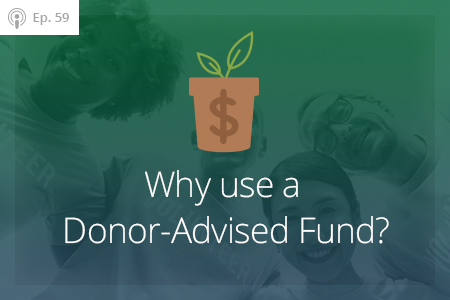 Charitable giving fills a need in our society and betters it as a whole. And until recently, donating to nonprofits helped people receive attractive deductions on their tax bills.
Charitable giving fills a need in our society and betters it as a whole. And until recently, donating to nonprofits helped people receive attractive deductions on their tax bills.
With the recent tax law change, it’s important to understand how your charitable contributions will affect your next tax return. We want to make sure that you continue to get the biggest tax benefit possible when giving to your favorite charities.
So in this episode, we discuss a strategy to help you find the best tax solutions for your charitable gifting going forward.
How charitable giving has been reshaped
The newest update to the tax law could limit charitable giving due to the increase in the standard deduction.
For many, it may be challenging to find ways to receive similar tax benefits for giving they were already doing. But there are solutions out there.
The first is to do nothing. With the 2018 tax law changes, most people will no longer receive the same benefit for giving to their favorite non-profits.
Your second option is to give the same amount to your favorite charities and lump your contributions so that you give a larger amount every other year rather than annually. This will allow a bigger tax benefit biannually this way. The downside to gifting directly to the charity is the disruption in annual cash flow for their regular operations. Nonprofits often rely on yearly contributions to stay afloat and this strategy could lead to financial problems for the charity.
What is a donor-advised fund?
A donor-advised fund may be one of the best tax solutions for the newest tax law changes.
You can set up a donor-advised fund with Fidelity, Vanguard, or Charles Schwab. This is an account where you can contribute the same amount that you usually do each year and realize the biggest tax savings over a period of time. This way the charity can still receive the same amount that you would normally give within the same timeframe. You can then distribute smaller amounts throughout the year to smooth your charitable contributions, so operations of the charity are not affected. A Donor-Advised fund can receive many kinds of capital and turn your investment into cash for your favorite nonprofits to use.
What are the best strategies for giving to a donor-advised fund?
It is best to start planning your tax year in the fall. With a donor-advised fund, you can give to your favorite nonprofit in many different ways, whether it be stocks, private equity, hedge fund interest, real estate, or cash. Your donor-advised fund will then give your favorite charity cash that they can use. You are able to set up your charitable donation to be gifted whenever you choose, whether it is weekly, monthly, quarterly, or yearly. Using a donor-advised fund is a great long-term tax strategy to use as part of the changing laws’ tax solutions.
Outline of This Episode
- [0:27] Changes in the new tax law
- [3:33] The new standard deduction for charitable giving has changed
- [5:30] What are your options?
- [6:45] What is a donor-advised fund?
- [10:48] How can you plan your estate with a donor-advised fund?
- [13:10] What are the best strategies for giving to a donor-advised fund?
Resources & People Mentioned
Connect With Chad and Mike
- https://www.financialsymmetry.com/podcast-archive/
- Connect on Twitter @csmithraleigh@TeamFSINC
- Follow Financial Symmetry on Facebook

